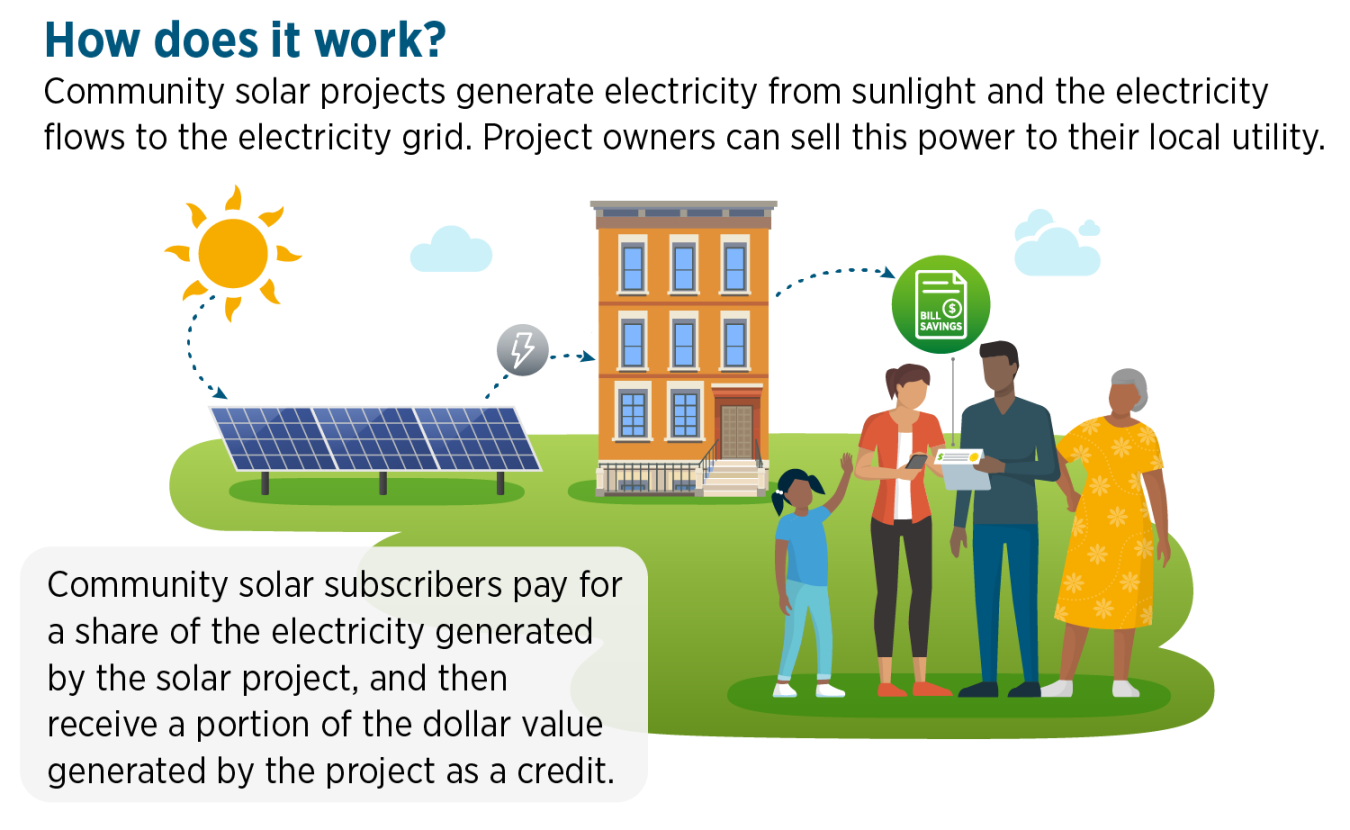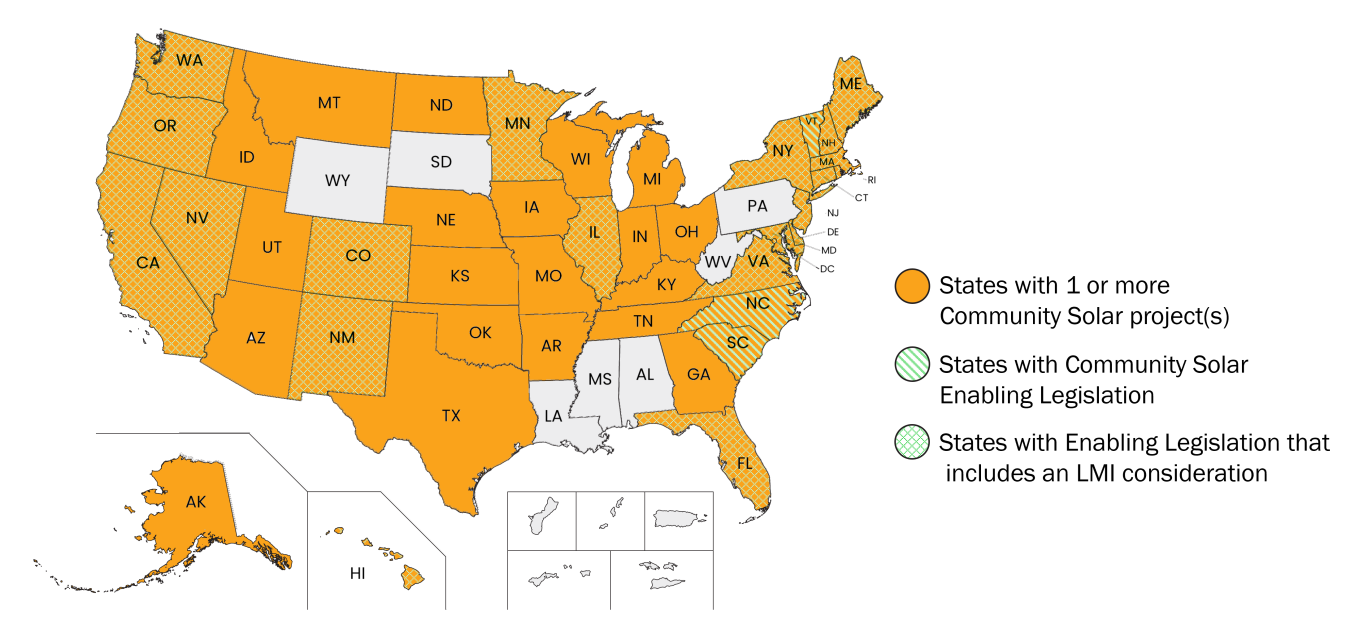What is Community Solar?
The U.S. Department of Energy defines community solar as any solar project or purchasing program, within a geographic area, in which the benefits flow to multiple customers such as individuals, businesses, nonprofits, and other groups. In most cases, customers benefit from energy generated by solar panels at an off-site array.
Community solar customers typically subscribe to—or in some cases own—a portion of the energy generated by a solar array, and receive an electric bill credit for electricity generated by their share of the community solar system. Community solar can be a great option for people who are unable to install solar panels on their roofs because they are renters, can’t afford solar, or because their roofs or electrical systems aren’t suited to solar.
Community solar is rapidly growing across the country. The National Renewable Energy Laboratory tracks installation data on community solar.
How Does Community Solar Work?
Community solar projects generate electricity from sunlight and the electricity flows through a meter to the utility grid. Community solar subscribers (i.e., households, businesses, or any other electricity customer) pay for a share of the electricity generated by the community solar project. This is typically in the form of a monthly subscription fee.
The local utility pays the community solar provider for the energy generated, and each subscriber receives a portion of the dollar value generated by their community solar subscription as a credit. Typically, this credit is applied directly to a subscriber’s monthly electric bill, helping to reduce customers’ electricity costs.

Why Community Solar?
Community solar can allow all households and businesses to access the benefits of solar energy, such as lower electricity costs, regardless of whether they’re able to host a system on their own roof. In addition to household savings, other benefits of community solar include resilience during blackouts or weather events, community wealth building, and local job creation. Learn more about the meaningful benefits of community solar.
According to analysis by the National Renewable Energy Laboratory, nearly 50% of households and businesses are unable to host rooftop solar systems. This may be because they don’t own their homes, have roof conditions that do not support a rooftop photovoltaic (PV) system due to shading, roof size, or other factors, or due to the upfront costs of installing home PV.
Consumer Protections in Community Solar
It is important that community solar programs incorporate key consumer protections to ensure subscribers receive strong benefits. Community solar programs designed for low-income households all require subscribers to achieve energy savings and often include other key consumer protections.
Some best practices in consumer protections for community solar include:
- Ensuring subscribers will receive a bill credit, including at least 20% household savings
- No exit fees, termination fees, sign-up fees, or other fees included in the contract
- Community solar disclosure documents are provided upfront with an overview of what will be included in the subscription, written in plain language and provided in the subscriber’s primary language
- Compliance protections must be in place, where there is an accessible complaint process or mechanism for community solar subscribers
Subscribers should check their state’s requirements for consumer protections in community solar programs and review their contracts when subscribing to ensure they receive strong and transparent protections.
Where Can I Find Community Solar?
Currently, there is at least one community solar project in 44 states and localities, including the District of Columbia (DC). Of those, 24 have passed "enabling legislation" that encourages or mandates community solar in their jurisdictions. States with enabling legislation typically have more projects developed and subscriptions available. Additionally, 19 states and DC have policies to address the participation of low-income households in community solar.

Resources for Finding Community Solar Projects
Consumers can contact their local electric utility or use an internet search engine to find community solar subscriptions that may be available to them in their areas. The signup process for community solar depends on your state and the programs available for enrollment.
Here are some helpful resources:
- National Renewable Energy Lab State Policies and Programs for Community Solar - This spreadsheet includes current community solar policies and low-income stipulations by state. If you’re interested in subscribing in a community solar program, states with active programs have websites that include more information on how to subscribe.
- Groundswell Low Income Financing and Transactions for Solar Access Everywhere Toolkit - This toolkit allows you to search for community solar programs based on their designs and their low-income financing structures.
Community Solar and Multifamily Housing
In addition to the more common off-site model of community solar, owners or occupants of apartment or condominium buildings may develop solar arrays on their property or rooftop, providing residents with energy produced from the rooftop array. Affordable housing can provide benefits to residents from community solar as either direct bill discounts or as indirect benefits. Learn more about community solar and affordable housing, including guidance from the U.S. Department of Housing and Urban Development on how community solar should not impact low-income utility allowances.
Investor-Owned Utilities, Municipalities, and Cooperatives
In states without community solar enabling legislation, non-regulated utilities or municipal utilities may develop their own community solar programs. Learn more about municipally led community solar programs.
Because most community solar arrays are located off-site, utilities can strategically locate these systems in areas of the grid that can benefit the most. For utilities, developing community solar arrays can lead to improved relationships and engagement with customers.
Learn More About Community Solar
The U.S. Department of Energy (DOE) Solar Energy Technologies Office (SETO) is advancing community solar through the National Community Solar Partnership, a coalition of community solar stakeholders working to expand access to affordable community solar to every American household by 2025. Partners leverage peer networks and technical assistance resources to set goals and work to overcome persistent barriers to expanding community solar access to communities.
Learn more about how solar works, community solar market trends, and SETO’s research into equitable solar access.

